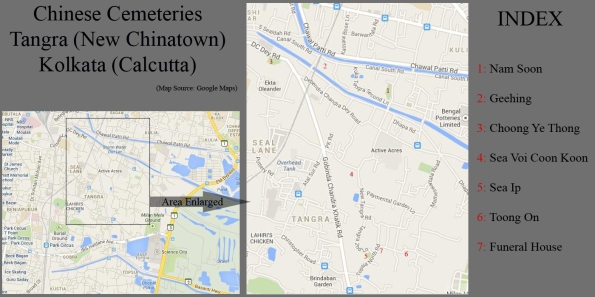Archive
Qingming (Tomb Sweeping Day), Tangra, Kolkata
Qingming (Tomb Sweeping Day)
Tangra (New Chinatown), Kolkata
Also see: My blog post on Calcutta (Kolkata) Chinatown
Qingming or the Tomb Sweeping Day is held on the 15 th day after the spring equinox and normally falls on 5 or 6 April.

Qingming (Tomb Sweeping) at Choong Ye Thong Cemetery, Tangra (New Chinaatown), Kolkata
On this day the Chinese pay tribute to their ancestors by cleaning the tombs and offering elaborate food spread in front of the graves. It can be considered as the Chinese version of the All Souls’ Day.
Fo Guang Shan Buddhist Temple, Tangra, Kolkata
Fo Guang Shan Buddhist Temple
New Chinatown (Tangra), Kolkata
Also see: My blog post on Calcutta (Kolkata) Chinatown and Buddhist Temple of Kolkata (Calcutta)
Tangra, Kolkata’s (Calcuta’s) new Chinatown, is known for its Chinese restaurants but it also houses the Fo Guang Shan Budhist Monastery, a Chinese Temple which doubles up as a Chienese eatery. during weekends.
Although the Chinese have made Kolkata (Calcutta) their home since the late 18th century, the Chinese settlement in Tangra only dates back to the 1920s.
Chinese Cemeteries of Tangra (New Chinatown), Calcutta (Kolkata)
Chinese Cemeteries of New Chinatown
Tangra, Kolkata (Calcutta)
Also see: My blog post on Calcutta (Kolkata) Chinatown
The Chinese settlement of Calcutta dates back to the late 18th century when a Chinese trader, Tong Achew settled near present day Budge Budge.
The, then Governor General of India, Warren Hastings, offered Achew land to set up a sugar mill complete with a sugar plantation. Achew soon brought a band of Chinese workers for his sugar project. But Achew died soon after and his mill was soon abandoned. The Chinese also deserted the place, which later came to be known as Achipur, after Achew.
TESTIMONIAL – I
Testimonial
From Prof. Tirthankar Roy,
Economic History Dept.
THE LONDON SCHOOL OF ECONOMICS
AND POLITICAL SCIENCE (LSE)
Six of my photos were selected for publication by Prof. Tirthankar Roy of the Economic History Dept. of the London School of Economics and Political Science (LSE) for his book titled “India in the World Economy” published by the Cambridge University Press.
Below is a testimonial from Prof. Roy

Testimonial from Prof. Tirthankar Roy, Economic History Dept., London School of Economics and Political Science
Here is the list of the selected six photos:
- Radhagobinda Temple, Aatpur (Antpur)
- Panel of European soldiers from Radhagobinda Temple, Aatpur (Antpur)
- Rajrajeshwar Temple, Darhawata
- Panel of Ship from Rajrajeshwar Temple, Darhawata
- Nanking Restaurant & Tong On Church, Calcutta (Kolkata)
- Abandoned Light House, Kulpi
PHOTOS OF AATPUR (ANTPUR)
Built in 1786 Krishnaram Mitra, the Dewan of Maharaja of Burdwan, constructed the huge Radhagobinda Temple. The towering aat – chala temple has a triple arched entrance and the entire front face is covered with the finest terracotta. The temple was constructed during an important transition period of Bengal history. This period marked the end of Muslim rule and the beginning of European era. The terracotta panels reflect this transition. Apart from traditional panels showing images of Gods & Goddesses, scenes from Ramayana & Krishnalila it also houses a vast number of panels showing European lifestyles. European soldiers with bayonet mounted guns and hunting scenes with dogs are abundant on the walls of the temple.
PHOTOS OF DARHAWTA
The Rajrajeshwar Temple of Darhawta was constructed in 1728 by Apurbamohan Singaroy. The base of the aat – chala (eight sloped roof) temple measures 24 feet by 21 feet and has a triple arched entrance. The entire front surface have intricate terracotta, but sadly most of these panels have been heavily damaged. The base panels consists of images of boats and ships.
PHOTO OF ABANDONED LIGHT – HOUSE, KULPI
The abandoned light house at Kalitala village is approached from the Sam Bose bus stop in Kulpi (near Diamond Harbour) by the Military road. The unpaved road, of about 3 km, is called locally as the Military Road but their are no concrete historical evidences of the origin of the name. Today the abandoned light house is reduced to half its original height and is located at the edge of the agricultural field. The light house is located quiet a distance from the Hooghly River and is separated from the river by a series of brick kiln.
With a circumference of about 10 feet the light house today towers to a height of about 25 feet and is built with bricks measuring 10.2 X 4.7 X 2.3 cubic inch. The structure lies in utter neglect and is totally overgrown with vegetation. The roots of the vegetation have embedded them deep in the structure and resulted in deep cracks stretching the entire length of the structure, it is a mystery that the structure still stands.
PHOTO OF NANKING RESTAURANT
At the Chattawalla Guli of of Tiretta Bazar of Central Calcutta (Kolkata) lies a elegant two storied building. The ground floor once housed the Nanking Restaurant. Opened in 1924 the Nanking Restaurant is the oldest Chinese restaurant in Calcutta (Kolkata) and also in India. The first floor housed the Tong On Chinese Temple.
A property dispute in 1980s closed both the restaurant and the temple and they remain closed to this day, denying the Calcuttans of their authentic Chinese food. The Tong On Church operates from a nearby house in Bow Street in Bou Bazar.
References:
Aatpur:
- Hooghly Jelar Purakirti by Narendranath Bhattacharya
- Next weekend you can be at … Antpur by Somen Sengupta, The Telegraph
- Links from my website Aatpur Travelogue
- Hooghly Jelar Purakirti by Narendranath Bhattacharya
- Dakshin 24 Pargana Jelar Purakirti by Sagar Chattopadhyay
- Jaywalkers Guide Calcutta by Soumitra Das
- Links from my website Chinese Temple of Old China Town, Calcutta (Kolkata)


















